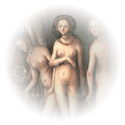The Kimbell Art Museum in Fort Worth, Texas, USA, announced the acquisition of a highly important and exceptionally well-preserved painting by the great German Renaissance artist Lucas Cranach the Elder (1472–1553)—the first of his several versions of "The Judgment of Paris". Dating from circa 1512–14, the work is an outstanding example of Cranach´s small oil-on-panel paintings of mythological subjects. The painting has been on loan to the Wallraf-Richartz Museum in Cologne, Germany, from 1968 to 1996.
 Along with Albrecht Duerer, Matthias Gruenewald, and Hans Holbein, Cranach the Elder was one of the foremost artists
of 16th-century Germany. He was both prolific and versatile, excelling in many genres and developing new subjects
informed by the precepts of humanist and Reformation thought. His manner dominated the art of the region of Saxony for
the entire century, and his influence, through both his paintings and his prints, reached throughout Germany,
the Netherlands, and Eastern Europe. From 1505, Cranach worked in Wittenberg as the court artist to Frederick the
Wise and his successors, the electors of Saxony. He established a large and productive workshop, which included
his sons Hans and Lucas the Younger. One of the city´s wealthiest and most respected citizens,
Cranach was a close friend of Martin Luther, the prime instigator of the Reformation, who taught at the University of Wittenberg.
He created numerous painted portraits and prints of the Reformer, and they were godfathers to each other´s children.
He crated also numerous paintings of a mythological subject featuring the
female nude.
Along with Albrecht Duerer, Matthias Gruenewald, and Hans Holbein, Cranach the Elder was one of the foremost artists
of 16th-century Germany. He was both prolific and versatile, excelling in many genres and developing new subjects
informed by the precepts of humanist and Reformation thought. His manner dominated the art of the region of Saxony for
the entire century, and his influence, through both his paintings and his prints, reached throughout Germany,
the Netherlands, and Eastern Europe. From 1505, Cranach worked in Wittenberg as the court artist to Frederick the
Wise and his successors, the electors of Saxony. He established a large and productive workshop, which included
his sons Hans and Lucas the Younger. One of the city´s wealthiest and most respected citizens,
Cranach was a close friend of Martin Luther, the prime instigator of the Reformation, who taught at the University of Wittenberg.
He created numerous painted portraits and prints of the Reformer, and they were godfathers to each other´s children.
He crated also numerous paintings of a mythological subject featuring the
female nude.
The tale of "The Judgment of Paris" is derived from Greek mythology. Who was the most beautiful of three goddess Hera, Athena or Aphrodite ? This was a question posed by the angry goddes Eris (Discord) because she was not invited to the wedding of of the human Peleus and see-goddess Thetis. In revange she tossed an golden apple labeled "to the fairest" among the banqueting Olympian gods. Zeus (Roman Jupiter), the organizator of this beuty contest, sent the messenger-god Hermes (Roman Mercury) to tell Paris, son of King Priam of Troy, to award the prize. Hera (Roman Juno) offered wealth and power, Atena (Roman Minerva) offered military prowess, and Aphrodite (Roman Venus) pledged the love of the most beautiful woman on earth. Paris´s choice of Aphrodite (Venus), and his abduction of the most beautiful woman—Helen, wife of the Spartan King Menelaus—led to the Trojan War.
Cranach´s painting of this tale was influenced by accounts of the Trojan War in medieval narratives, particularly Guido delle Colonne´s "Historia Destructionis Troiae" (1287, German translation 1477). According to this source, Paris tethers his horse and falls into a deep sleep after losing his way in the groves of Ida during a hunting expedition. The god Mercury appears to him in his dream and presents the three goddesses, demanding that he select the fairest. Paris refuses to make his choice until they disrobe.
 Cranach´s depiction of Paris as a knight in armor, sitting near a fountain in front of the three nude goddesses in the inclusion of
a forest glade is not new and can be found in earlier German paintings. However, the most striking and original features of the Cranarch´s
work is the landscape setting. The depiction of the nature with its mossy tree-trunk anchoring the center,
the misty mountainous vista at left, and the turreted castle crowning a rocky precipice in the right background is very new.
Paris stunned expression denotes both his dream-state and the difficulty of his choice. He wears a red robe over a
full set of armor and an elaborate ostrich-plumed hat.
Cranach´s depiction of Paris as a knight in armor, sitting near a fountain in front of the three nude goddesses in the inclusion of
a forest glade is not new and can be found in earlier German paintings. However, the most striking and original features of the Cranarch´s
work is the landscape setting. The depiction of the nature with its mossy tree-trunk anchoring the center,
the misty mountainous vista at left, and the turreted castle crowning a rocky precipice in the right background is very new.
Paris stunned expression denotes both his dream-state and the difficulty of his choice. He wears a red robe over a
full set of armor and an elaborate ostrich-plumed hat.
 The long-bearded Mercury, depicted in the medieval tradition as a
sage, is dressed in ornate golden armor, with a highly wrought winged helmet. He holds a crystal sphere encircled by a golden
band inscribed with the letters "AMORT.X.N." Recalling the imperial orb, this fragile globe suggests the momentousness of Paris´s
decision for the fate of the ancient world. The ambiguous letters suggest both "amor" (love) and perhaps "mortalis"
(subject to death), possibly
alluding to Paris´s fatal choice that led to the destruction of Troy.
The long-bearded Mercury, depicted in the medieval tradition as a
sage, is dressed in ornate golden armor, with a highly wrought winged helmet. He holds a crystal sphere encircled by a golden
band inscribed with the letters "AMORT.X.N." Recalling the imperial orb, this fragile globe suggests the momentousness of Paris´s
decision for the fate of the ancient world. The ambiguous letters suggest both "amor" (love) and perhaps "mortalis"
(subject to death), possibly
alluding to Paris´s fatal choice that led to the destruction of Troy.
The goddesse nudity is underscored by golden chains, fine hairnets, and diaphanous veils. The central goddess reflects the influence of the classicizing nudes of Duerer and Jacopo de Barbari, the Italian artist who preceded Cranach as Saxon court painter. The goddess at right demurely rubs her feet together as she turns toward the viewer, elegant curls framing her delicate features and blushed cheeks. At left, another beauty more aggressively makes her plea to Paris. Painted without attributes, the goddesses are difficult to identify.
Like other popular mythological and religious subjects painted by Cranach, "The Judgment of Paris" was often understood
as depicting "Weibermacht," (the power of women over men) where even strong or wise men, such as Hercules, Samson,
or Aristotle, were subjugated by the beauty or wiles of women. However, Cranarch may have had in mind more complex
moralizing meaning.
We know that "The Judgment of Paris" was
thought to be a fitting subject for the instruction or flattery of princes. At the 1494 festive entrance of
Philip the Fair into Antwerp, the myth was presented as a "tableau vivant" in which the nude goddesses appeared before
the dreaming
Paris and Mercury—an event witnessed by Frederick the Wise of Saxony. As a poetic conceit, various princely families, including
the Hapsburgs and Wettins (the family of Frederick the Wise), traced their lineage to the Trojans.
"The Judgment of Paris" was also a popular theme in the scholastic, humanist circles that Cranach frequented, and current moralizing interpretations of the myth likely informed the artist´s paintings. Latin plays and texts intended for students construed the Judgment as the choice between Pleasure and Virtue, taking the occasion to warn against the perilous powers of Venus. In his 1503 graduation address at the newly founded Wittenberg University, Nikolaus Marschalk took the "The Judgment of Paris" as his theme, and referred to the late-antique Latin allegorist Fulgentius´s influential interpretation of the myth as the choice between the "vita triplex" (three-fold life), consisting of the "vita contemplativa" (Minerva), the "vita activa" (Juno) or the "vita voluptuaria" (Venus). Marschalk warned against Paris´s terrible choice in favor of Venus. The Florentine philosopher Marsilio Ficino argued that to choose any one of the three ways of life, excluding the others, would lead to error. Thus all three goddesses should be embraced according to their merits since Minerva, or the contemplative life, leads to knowledge (sapientia); Juno and the active life to power (potentia); and Venus to grace and the arts (voluptas). It is possible that this view was known to German humanists like Conrad Celtis, who had been in contact with Ficino in Italy, and in turn to Cranach. Be that as it may, Cranach appears to tease Paris—as well as the viewer—with an agonizing choice. The goddesses, who offer power and might, wisdom, and love, are nearly indistinguishable, and equally enticing in their beauty.
The 17 by 12 3/4-inch panel is made of limewood (linden), which was a common support in Germany due to its fine grain. The surface was prepared with a smooth white ground, which is likely chalk bound with animal-hide glue. Cranach loosely sketched in the general composition with black ink applied with a brush. Slight shifts, such as the goddesses’s hands and feet, are the only deviations from the underdrawing that were made in the painting stage. The paint layer is meticulously built up in opaque and translucent oil layers followed by glazes and fine details. Gold is imitated by touches of lead-tin yellow, a color also used in his winged-serpent signature device in the lower left.
 "The Judgment of Paris" is one of the most popular of all mythological themes in art.
This delilghtfully ornamental dish may have been given as a wedding present to a newly married couple.
Painted around 1440 probably by Cecchino da Verona, it depcts three goddesses wearing
richly and beautifully embroidered dressess and golden diadems, which resemble aureoles, but do not wholly surround their heads.
"The Judgment of Paris" is one of the most popular of all mythological themes in art.
This delilghtfully ornamental dish may have been given as a wedding present to a newly married couple.
Painted around 1440 probably by Cecchino da Verona, it depcts three goddesses wearing
richly and beautifully embroidered dressess and golden diadems, which resemble aureoles, but do not wholly surround their heads.